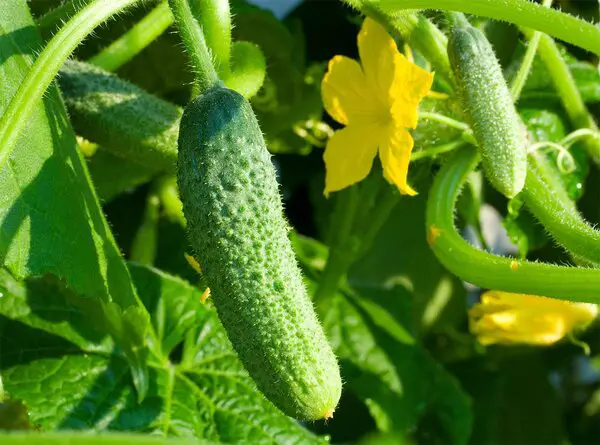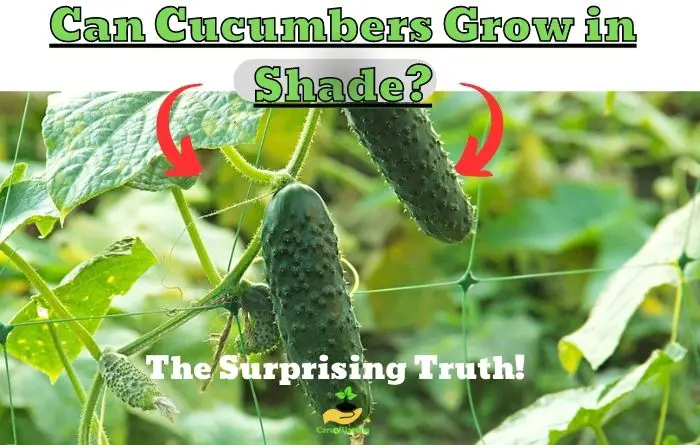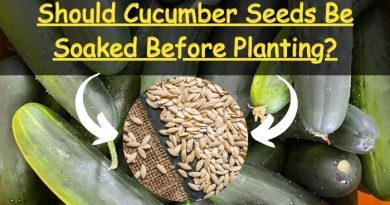Will Cucumbers Grow in Shade? The Surprising Truth!
Are you an avid gardener but don’t have a sunny backyard to grow your cucumbers? Do you have limited space or live in an urban area with tall buildings blocking the sunlight? As an experienced gardener, I often get asked if cucumbers can grow in shade.
From my experience, I can attest that cucumbers can grow in shady areas, but to ensure healthy growth, consider several factors. Sunlight is one of the main requirements for plant growth, and although cucumbers prefer sunny locations, they can adapt to partial shade conditions.
This article will discuss the main factors to consider when growing cucumbers in shade and some tips for success in low-light conditions.
Will cucumber grow in shade?
Absolutely! While cucumbers do prefer full sun, they can still grow and thrive in partial shade. In fact, providing some shade during the hottest part of the day can help prevent heat stress and sunburn on your cucumber plants. To successfully grow cucumbers in shade, choose a location that receives at least 6 hours of direct sunlight and provide them with rich, well-draining soil and consistent moisture. With these tips and a little patience, you’ll be enjoying a delicious harvest of cucumbers in no time!
When growing cucumbers in shaded areas, it’s necessary to provide as much light as possible, whether direct or indirect.
Another option is to make the most of indirect light, choosing an area close to a light wall or reflective surface that can reflect sunlight and direct it toward the cucumber plants.
It is worth mentioning that although it is possible to grow cucumbers in shady conditions, the productivity and growth rate of the plants will be affected. Light availability will directly influence plant health and crop yield.
Although cucumbers are less shade tolerant when compared to other plants, some varieties are more adaptable to low-light conditions.
Table with cucumber varieties that are known to be tolerant to shade:
| Cucumber Variety | Tolerance to Shade | Hours of Direct Sunlight Required |
|---|---|---|
| Salad Bush Hybrid | High | 6+ hours per day |
| Sweet Success Hybrid | High | 6+ hours per day |
| Marketmore 76 | Medium to High | 6+ hours per day |
| Straight Eight | Medium to High | 8-10 hours |
| Diva | Medium to High | 6+ hours per day |
| Spacemaster 80 | Medium to High | 6+ hours per day |
| Fanfare | Medium to High | 6+ hours per day |
| Bush Champion | Medium to High | 6+ hours per day |
| Suyo Long | Medium | 6+ hours per day |
| Lemon | Medium | 8-10 hours |
| Armenian | Low | 8-10 hours |
Factors to consider when growing cucumbers in the shade

If growing cucumbers in shady areas, here are some helpful tips.
Ideal amount of light
Cucumbers are plants that need significant sunlight to grow and develop properly. Although it is possible to grow them in shaded areas (as long as they receive at least 4 hours of direct sunlight per day), the plant can not reach its maximum productivity.
Always monitor the amount of light available in the growing area and the plant’s health to ensure cucumbers receive the necessary amount of light.
Shade-adapted varieties
Through crossbreeding and individual selection, some varieties of cucumbers have already adapted to a lower need for light. When choosing to grow cucumbers in shady conditions, choose those known for their adaptation to lower-light environments.
These varieties are tolerant of partial shade conditions and are likely to do well in these conditions. Consult a gardening specialist or research shade-adapted varieties available in your area before starting your cultivation.
Proper plant spacing
When grown in shade areas, cucumbers (like almost all plants) tend to extend their stems and leaves in search of more light (this is called etiolation).
Due to this abnormal growth, it is essential to properly space the plants, thus allowing more space to develop and a more uniform penetration and distribution of available light.
Proper spacing also prevents plants from overlapping each other, causing excessive shading and stunting the healthy growth of cucumbers. Follow the manufacturer’s guidelines for the best spacing for the specific cucumber variety you are growing.
Adequate fertilization
Under shady conditions, cucumbers may face challenges related to optimal nutrition to stay healthy. That is why it is so crucial to provide adequate fertilization. Fertilizing will provide all the nutrients the plant needs, increasing light absorption efficiency.
I always recommend the use of organic fertilizers. Remember to apply all necessary nutrients.
Pollination
In shaded areas, there may be fewer pollinating insects such as bees, which may affect the fruiting of cucumbers.
To ensure good pollination, you can use manual techniques such as using a brush to transfer pollen between flowers.
Tips to grow cucumbers in shade conditions:
In addition to choosing the right variety, monitoring the plants, and providing the least quantity of light, other tips will make your shade cucumber production successful.
Proper positioning
When growing cucumbers in the shade, choose a location where the plants can receive the maximum amount of available sunlight. Position them strategically, next to a white wall or in an area with light reflection.
Support structures
To deal with etiolation (plants that are more stretched due to the shaded condition), a great way out is to use support structures, such as trellises, conductor wires, or grids.
These structures will provide the necessary support for the plants to grow without overlapping and help them to extend vertically and make the most of the available light.
Adequate watering
When talking about plants, watering is always a crucial factor. Regularly monitor soil moisture and water the cucumbers as needed. The lack of direct sunlight can reduce the evaporation rate. It’s necessary to avoid excessive humidity, as this can favor the development of fungal diseases.
Pest and disease control
Plants grown in partial shade may be more susceptible to pests and diseases. Regularly monitor your plants and take preventive measures, such as using biological control techniques or applying natural products to control pests and diseases.
Weed management
Weeds compete with cucumbers for resources like nutrients and light. Keep the growing area free of weeds by removing weeds regularly and applying a layer of mulch to help suppress the growth of these unwanted weeds.
Regular harvest
Make regular harvests of ripe cucumbers. Removing the fruits that are ready to be eaten stimulates the plant to produce new fruits. In addition, the harvester prevents the ripe fruits from being in excessive shade or causing greater shading.
Supplementary artificial lighting
If the available natural light is insufficient for the healthy cultivation of cucumbers, you can supplement it with artificial lighting. Nowadays, we can easily find several lights and luminaries suitable for growing plants, usually LEDs.
Position the artificial lighting system just above the plants, covering them. Follow the manufacturer’s guidelines for proper lighting distance and time. Adjust the intensity and duration of lighting (photoperiod) according to the needs and stage of plants development.
Problems with growing cucumbers in shade
When growing cucumbers in shady areas, you should know that some problems can arise due to the poor availability of direct sunlight. Below we discuss some of these issues and how to address these issues.
Limited growth
Lack of adequate sunlight can lead to a limitation in plant development and growth. With less available light, plants may experience slower growth, weaker stems, and lower flower and fruit production.
To remedy this problem, choose shade-adapted cucumber varieties and provide adequate aperture and spacing to allow even light distribution. You may also consider using supplemental artificial lighting to provide the necessary amount of light for the plants.
Fungal diseases
The lack of direct sunlight can cause prolonged humidity, especially in areas close to the substrate. These moist, shaded parts create an environment conducive to the development of fungal diseases such as powdery mildew and gray mold.
To prevent this issue, just ensure good air circulation around the plants. Proper pruning, the removal of infected leaves, and proper spacing will help increase air circulation and reduce humidity.
Avoid wetting the entire cucumber plant and choose cucumber varieties that are more resistant to fungal diseases.
Limited pollination
Bees in particular are essential for the proper pollination of cucumber flowers, which leads to the formation of healthy fruits. To ensure that the flowers are properly pollinated, there are some methods of hand pollination.
Other outings include renting a pollinating bee box (yes, that’s a thing) or planting plants nearby that attract pollinators.
Nutrient deficiencies
Lack of direct sunlight can lead to nutritional deficiencies. Regularly monitor the health of your plant, look for symptoms of deficiencies (such as discoloration on the leaves), and fertilize as needed. Use balanced and nutrient-rich fertilizers.
Here is a table I’ve compiled summarizing the information on cucumber growth and yield in shade versus full sunlight:
| Factor | Cucumber Growth in Shade | Cucumber Growth in Full Sun |
|---|---|---|
| Height | Shorter and leggy | Taller and sturdier |
| Leaves | Smaller and fewer | Larger and more abundant |
| Flowering | Delayed | Earlier |
| Yield | Lower | Higher |
| Fruit Quality | Less uniform and misshapen | More uniform and higher quality |
“Cucumber.” University of Minnesota Extension. https://extension.umn.edu/vegetables/growing-cucumbers#shade-tolerant-varieties-1397713 (accessed October 7, 2021).
Othman, R., et al. “Effects of Shade on Cucumber Yield and Quality.” Journal of Horticultural Science and Biotechnology 81, no. 4 (2006): 613-618. https://doi.org/10.1080/14620316.2006.11512083
Javanmard, M., et al. “Effect of Shade on Yield and Quality of Greenhouse Cucumber.” Journal of Applied Horticulture 12, no. 1 (2010): 3-6. https://doi.org/10.1016/j.scienta.2008.09.010
Conclusion
When facing these problems when growing cucumbers in the shade, it is critical to closely monitor the growth and health of the plants. Conduct regular inspections, make necessary corrections, and adjust your growing practices as needed. With proper care and adaptations, it is possible to overcome the challenges and obtain satisfactory cultivation of cucumbers.
Frequently Asked Questions
Cucumbers require at least 6-8 hours of sunlight per day to grow and produce fruit. Without enough sunlight, cucumber plants may become weak and produce fewer cucumbers or even stop producing altogether. If you are growing cucumbers in a location with less sunlight, consider using reflective materials to increase the amount of light they receive.
Cucumbers are sun-loving plants that need a lot of light to grow and produce a bountiful harvest. However, they can tolerate some shade, especially during the hottest part of the day. Ideally, they should receive at least 6-8 hours of direct sunlight, but they can still grow and produce fruit with as little as 4 hours of sunlight.
Yes, cucumbers generally produce less fruit when grown in shade as they require at least 6 hours of direct sunlight daily to thrive and produce abundant fruit. Shade can reduce the photosynthesis process, which is crucial for plant growth and fruit production.




